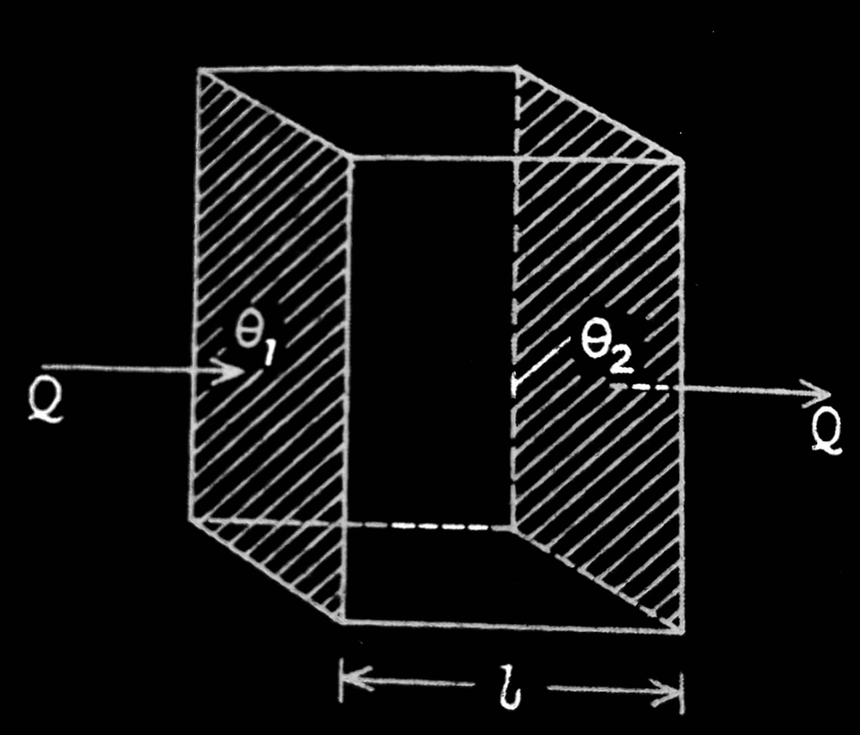Thermal Conductivity Unit - Definition, Formula, FAQs
Key points of this article
- Thermal conductivity
- Unit and dimension of thermal conductivity
- Thermal resistance
- Coefficient of thermal conductivity
Thermal conductivity:- It is the capacity of a material to conduct the heat. Thermal conductivity is denoted by K which is known as the coefficient of thermal conductivity.
Also read -
- NCERT Solutions for Class 11 Physics
- NCERT Solutions for Class 12 Physics
- NCERT Solutions for All Subjects
What is the coefficient of thermal conductivity?
Let’s discuss, Suppose a parallel-faced slab. The cross-sectional area is A and length l of this slab. The temperatures of the faces are at a steady temperature ?1 and ?2. Heat will flow through the face at a higher temperature ?1 to that at a lower temperature ?2. Let us assume that there is no heat that comes out from the edges of the slab. Thus, the line of the flow will be normal at all points of the faces of the slab. In these situations, under steady-state, the quantity of heat Q entering one face at a given time is the same as the heat leaving the other face at the same time.


The test shows that the heat Q is
(i) directly proportional to the cross-sectional area A of each face,
Q ∝ A …..1
(ii) directly proportional to the temperature difference (?1 -?2 ) between two faces,
Q ∝ (?1 - ?2 ) …...2
(iii) directly proportional to the time t . ( time for which the heat flows in the slab),
Q ∝ t …..3
(iv) inversely proportional to the length of the slab (distance between hot and cold faces),
Q ∝ 1/l …..4
From eqn 1, 2, 3, and 4 we have

![]()
Where k is a constant which depends upon the material. It is called the coefficient of thermal conductivity. The quantity (?1 - ?2 )/l is the “temperature gradient” across the slab. It is a measure of the change in temperature with distance. SI unit of temperature gradient is Kelvin/meter.
If A = 1, (?1 - ?2 )/l = 1 and t = 1, then K = Q. Therefore, the coefficient of thermal conductivity K of a material is defined as the amount of heat that flows in unit time through the unit area of the material perpendicular to the flow under unit- temperature gradient, when the steady-state has been reached.
If K is large for material then it is a good heat conductor, whereas If K is small for material then it is a poor conductor of heat. For an ideal or perfect heat conductor, K will be infinite, and for a perfect heat insulator, the value of K is zero.
In case when the heat escapes out from the sides of the slab, the temperature gradient is not uniform across the slab. In such a case, if θ and θ + ?θ be the temperature at a plane distance x and x + ?x along the direction of heat flow, then the temperature gradient will be θ - ( θ + ?θ )/?x = -?θ/?x. In the limit ?x→0; this becomes -dθ/dx which is the temperature gradient at the plane x. ( The negative sign expresses the fact that the temperature always decreases in the direction of heat flow ). Then, the heat dQ flowing across the plane x in time dt will be given by

The rate of flow of heat is
![]()
The unit of thermal conductivity:- We know that
![]()
We get,

Thus, SI unit of coefficient of thermal conductivity is Js-¹m-¹K-¹ or Wm-¹K-¹. CGS unit of coefficient of thermal conductivity K is expressed in cal.s-¹cm-¹°C-¹
Related Topics Link, |
Thermal conductivity also has the dimensional formula. So, what is the dimensional formula of thermal conductivity?
Dimensional formula of thermal conductivity:- Coefficient of thermal conductivity dimensional formula is [MLT-¹?-¹].
- The ratio of the coefficient of thermal conductivity of two different materials is 5:3. If the thermal resistance of the rod of the same thickness resistance of the rods of the same thickness of these materials is the same, then the ratio of the length of these rods will be
Solution:- Let the coefficient of thermal conductivity of two different materials is represented by K1 and K2.
So, K1/K2 = 5/3
Given, the thermal resistance of rods is the same R1 = R2
We know that R = l/KA
∴ A1 = A2 = A
R1 = R2
l1/K1A = l2/K2A
l1/5 = l2/3
l1/l2 = 5/3
So, the ratio of the length of these rods 5:3
Also Read:
- NCERT solutions for Class 11 Physics Chapter 11 Thermal Properties of Matter
- NCERT Exemplar Class 11 Physics Solutions Chapter 11 Thermal Properties of Matter
- NCERT notes Class 11 Physics Chapter 11 Thermal Properties of Matter
Thermal resistance:- Just as charge flows in an electrical circuit due to a potential difference between two points of the circuit, in the same way, heat flows in a conductor due to a temperature difference between two conductors (or b/w two points of the conductor). Hence, like electrical resistance, there is also thermal resistance in a material.
Let l be the length and A be the area of cross-section of a rod. Let θ1 and θ2 be the temperatures of the hot and cold ends of the rod in the steady-state. The rate of flow of heat is given by

![]()
When a current flows in a conductor, the ratio V/i is called the electric resistance R of the conductor, where V is the potential difference between the ends of the conductor and i is the current and rate of flow of charge in a conductor. In the above formula (θ1 - θ2 ) is the temperature difference between the ends of the conductor and H is the rate of flow of heat. On this basis, (θ1 - θ2 )/H is called the thermal resistance R of the conductor. Thus,![]()
From the above equation, If the coefficient of thermal conductivity of a material is greater, the smaller is the thermal resistance of a rod of that material.
SI unit of thermal resistance:- The unit of thermal resistance is second°C/kilo-calorie.
Dimensional formula of thermal resistance:- The dimensional formula of thermal resistance is [M-¹L-²T³?].
Thermal conductance:- It is the ability of a material to measure the heat transfer per unit time. The thermal conductance unit or conduction unit is W⋅K−1
Also check-
- NCERT Exemplar Class 11th Physics Solutions
- NCERT Exemplar Class 12th Physics Solutions
- NCERT Exemplar Solutions for All Subjects
NCERT Physics Notes:
Frequently Asked Questions (FAQs)
Dimension of coefficient of thermal conductivity or dimension of conductivity is [MLT-¹?-¹].
Unit of thermal conductivity is ( or unit of coefficient of thermal conductivity) SI unit of thermal conductivity is Js-¹m-¹K-¹ or Wm-¹K-¹.
The formula of coefficient of thermal conductivity is
Q = KA. (θ1 - θ2 )t/l
So, K = (Q/t)/(A/l).(θ1 - θ2 )
Where K is the coefficient of thermal conductivity.
Thermal conductivity or the coefficient of thermal conductivity K of a material is defined as the amount of heat that flows in unit time through the unit area of the material perpendicular to the flow under unit- temperature gradient when the steady-state has been reached.
The unit of thermal conductivity is Js-¹m-¹K-¹ or Wm-¹K-¹.
The thermal resistance is the ratio of length of the rod of the material and the product of the coefficient of thermal conductivity and the area of cross-section of the rod.
R = l/KA
Where, l= length of rod
K = thermal conductivity
A = area of cross-section.
If the resistance increases thermal conductivity decreases and vice versa.
The SI unit of thermal resistance is second°C/kilo-calorie.
Also Read
02 Dec'24 12:36 AM
21 Nov'24 01:48 PM
20 Nov'24 10:28 AM
18 Nov'24 05:26 PM
12 Nov'24 11:55 PM
12 Nov'24 11:20 PM
12 Nov'24 09:27 PM
25 Sep'24 06:28 PM
25 Sep'24 11:47 AM
24 Sep'24 09:56 PM